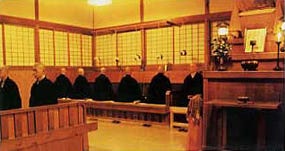One day, the World-Honored One ascended the seat. Manjushri swung the gavel and said, “Examine! Look! The dharma of the dharma sovereign - the dharma of the dharma sovereign is thus.”
The World-Honored One descended the seat.
Such a simple scene!
The World-Honored One (so called because they had turned the light around and realized that they are not the ten-thousand things, but the ten-thousand things, in fact, are them) gets up on the seat to teach.
Manjushri, the awakening being that champions nondual wisdom and who is often depicted in the Great Vehicle literature as a young punk (a 16-year old who is brazenly willing to check the awakening of all Buddhas), clearly sees that the teaching is complete and responds immediately.
In the old sutras, the Buddha and Manjushri are often found engaged in pointed dialogues about the essential matter. This brief koan sounds like it is extracted from one such sutra, but that isn’t the case. Instead, the story belongs to a body of Zen lore that travelled a less formal path to reach us - not on the high seats in the monasteries, but in the back rooms, mouth to ear, heart to heart.
Just as the Buddha ascends the seat to teach, Manjushri swings the gavel and strikes the tsuichin (an octagonal wooden instrument used to signal monastics - in the photo below, it’s to the left of the altar with a cloth draped across the top), telling the practitioners that the talk has ended.
In striking the gavel and saying what he says, Manjushri might be simply and completely following the protocol of ancient Chinese monasteries and reciting the words that end any dharma talk by an dharma master: “Examine! Look! The dharma of the dharma sovereign - the dharma of the dharma sovereign is thus.”
On the other hand, the lore about Manjushri’s decisive action might have established this very protocol.
In other words, we don’t know if this koan became the model for ending dharma talks in the monasteries, or if the manner of ending dharma talks catalyzed the creation of this koan. Did the koan lead to reality or did reality lead to the koan? And is there a difference?
Examine! Look!
Okay, but look where for what? Don’t go thinking that the Buddha’s silence was more of expressive of nonduality than Manjushri’s words - that’s just duality masquerading as the nondual.
The dharma of the dharma sovereign - the dharma of the dharma sovereign is thus.
Thus? How’s that?
Above are the key points of the koan.
Had the Buddha spoken, he might have given a brilliantly buddhalogical teaching - that might have lead those hearing the teaching to think they understood. As you may know, though, an explanation, even a brilliantly buddhalogical one, will not reach the mysterious pivot of this or any koan - or the beating heart of this one life.
Thank Buddha, then, that Manjushri pointed to it by ending the talk. Well, he did say a few words. But the time for derivative off-gassing has long passed. And the Buddha got down from their high seat and went back to their room.
So begins the journey through The Record of Going Easy’s 100 koans. At this point, the chorus might break into song with “99 more koans of it on the wall, 99 more koans of it, take one down and pass it around….”
Wansong, in his commentary to this koan breaks into no such song, but says that when the Buddha got down from the high seat and went back to their room:
“For the time being, he saved one half. That one half he allotted to Tiantong.”
“Saved one half” refers to the dharma lore that a Buddha is supposed to live 100 years, but Shakyamuni only lived 80, and bequeathed 20 years of Buddha life to their descendants. The Buddha of our Zen-lore koan is more generous and leaves half for Tiantong to live out in verse:
Tiantong’s Verse
The one true wind - what do you see?
Continuous transformation, the mother of the inner essence, pivots back and forth,
weaving the ancient brocade, containing the form of spring.
How is it that nothing can be done about Manjushri’s leaking?
What do you see?
The continuous ungraspable flow of birth-death beyond our discriminating mind’s evaluations? Is that what you see?
Likewise, even though Manjushri embodied nonduality and did exactly what the situation called for, either establishing protocol or perfectly embodying protocol, still, Tiantong sees that he was leaking protocol all over the place.
In just this way, it is said that the spirit tortoise brushes away their tracks with their tail, but then leaves the tracks of their tail. In the continuous weaving of creation, how can you leave no trace?
Wansong comments:
“Attentive to the lilac buds kindly opening, the tips of the branches share the sovereignty of spring.”
I say, up high, down low, too slow.
Thank you for reading.
Coming Soon
Opening the World: A Conversation with James Myoun Ford Roshi







I don't know if I have the eye or even half an eye, but what the heck... Whack!, descending.
Your photo reminds 'me' of, is it called The Great Wave off Kanagawa*', by the Japanese artist, Hokusai?
Your photo creates a similar 'opening', worth a 1000 words, Dosho.
It could be the Buddha said nothing, literally, as language falls short, woefully.
Thus, he stepped down, embarrassed to find himself there?
* 1831
👋